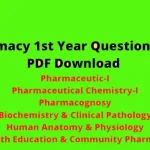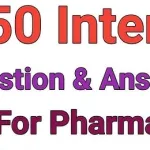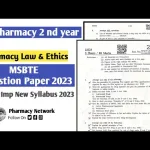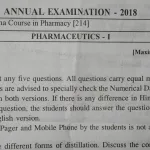Pharmaceutical microbiology is the study of microorganisms related to pharmaceuticals, including their role in drug production, contamination, and safety. It focuses on sterilization methods, microbial contamination, aseptic techniques, and the use of antibiotics and vaccines. This field ensures that medicines are safe, effective, and free from harmful microbes.
Lecture Notes:
1. Introduction to Pharmaceutical Microbiology
Pharmaceutical microbiology deals with the study of microorganisms that are involved in the production, contamination, and safety of pharmaceutical products. These microorganisms include bacteria, fungi, viruses, and protozoa. Pharmaceutical microbiology ensures that drugs are free from microbial contamination and are safe for human consumption.
Microbiology is essential because some microorganisms are used in the production of antibiotics, vaccines, enzymes, and vitamins, while others can cause contamination and spoil pharmaceutical products. Understanding these microorganisms helps in controlling and eliminating their harmful effects in drug manufacturing.
2. Types of Microorganisms
In pharmaceutical microbiology, the focus is primarily on four types of microorganisms:
- Bacteria: Single-celled organisms that come in various shapes like rods, spheres, or spirals. Some bacteria are beneficial, while others are harmful and cause diseases.
- Viruses: Smaller than bacteria, viruses need a host cell to replicate. They can cause a wide range of diseases, including influenza and HIV.
- Fungi: These include yeasts and molds. Some fungi are used to produce antibiotics, but others can spoil pharmaceutical products.
- Protozoa: Single-celled organisms, some of which can cause diseases like malaria.
3. Importance of Sterilization
Sterilization is the process of killing or removing all forms of microorganisms, including bacteria, viruses, fungi, and spores from an object or surface. It is a critical step in pharmaceutical manufacturing to ensure that the products are free from microbial contamination. The common methods of sterilization include:
- Heat Sterilization: Involves the use of high temperatures to kill microorganisms. There are two types:
- Moist Heat Sterilization: Uses steam under pressure (autoclaving).
- Dry Heat Sterilization: Uses dry air at high temperatures (hot air oven).
- Filtration: Involves passing a liquid or gas through a filter to remove microorganisms.
- Radiation Sterilization: Uses gamma rays or ultraviolet light to sterilize surfaces and packaging.
- Chemical Sterilization: Involves using chemicals like ethylene oxide or hydrogen peroxide to sterilize medical devices and pharmaceutical equipment.
4. Aseptic Techniques
Aseptic techniques are practices and procedures used to prevent contamination by microorganisms. This is crucial in the pharmaceutical industry, especially during the preparation of sterile products like injectables and eye drops. Key aseptic techniques include:
- Using sterilized equipment and maintaining a sterile environment.
- Wearing protective clothing like gloves, masks, and gowns.
- Frequent hand washing and use of alcohol-based sanitizers.
- Proper disposal of contaminated materials.
5. Microbial Contamination in Pharmaceuticals
Microbial contamination occurs when microorganisms enter pharmaceutical products during manufacturing, packaging, or storage. Contaminated products can lead to serious health risks, including infections or reduced effectiveness of the drug. Sources of microbial contamination include:
- Raw materials
- Water used in manufacturing
- Airborne particles
- Personnel handling the products
To prevent contamination, pharmaceutical companies follow strict guidelines and use cleanrooms with filtered air, sterilized equipment, and trained personnel.
6. Antibiotics and Antimicrobial Agents
Antibiotics are drugs that kill or inhibit the growth of bacteria. They are one of the most significant discoveries in medicine, used to treat bacterial infections. Some common antibiotics include penicillin, amoxicillin, and ciprofloxacin.
Antimicrobial agents are substances that kill or stop the growth of microorganisms, including bacteria, fungi, and viruses. These agents are used not only in medicines but also in disinfectants and preservatives.
7. Microbial Assays and Testing
In pharmaceutical microbiology, testing for microbial contamination is essential. Some common tests include:
- Sterility Testing: Ensures that the product is free from all viable microorganisms.
- Endotoxin Testing: Detects the presence of toxins released by bacteria that can cause fever and inflammation.
- Bioburden Testing: Measures the number of viable microorganisms present on a surface or in a product.
8. Microorganisms in Pharmaceutical Production
Some microorganisms are beneficial and are used in the production of pharmaceuticals. For example:
- Penicillin is produced by the mold Penicillium notatum.
- Vaccines are developed using weakened or inactivated forms of viruses or bacteria.
- Probiotics contain beneficial bacteria that help maintain gut health.
9. Spoilage and Preservation
Pharmaceutical products, especially those containing water, are susceptible to microbial spoilage. Spoilage can occur due to bacteria, fungi, or molds that grow in the product, leading to changes in color, odor, and effectiveness. To prevent spoilage, preservatives are added to pharmaceutical products. Common preservatives include:
- Benzalkonium chloride: Used in eye drops and nasal sprays.
- Methylparaben and propylparaben: Used in creams and lotions.
10. Immunization and Vaccines
Vaccines are biological products that stimulate the immune system to recognize and fight specific infections. They contain antigens derived from the microorganisms that cause the disease. When injected into the body, the immune system responds by producing antibodies, preparing it to fight the real infection if exposed in the future.
Examples of vaccines include those for polio, hepatitis B, and influenza. Vaccines have greatly reduced the spread of many infectious diseases.
11. Biosafety and Biohazards
In pharmaceutical microbiology, safety is a top priority. Handling microorganisms, especially pathogenic ones, requires proper biosafety measures to prevent infection and contamination. Some key biosafety practices include:
- Using biosafety cabinets to work with microorganisms.
- Proper disposal of biohazardous waste.
- Wearing protective clothing like gloves, masks, and lab coats.
- Using disinfectants to clean work surfaces and equipment.
12. Emerging Trends in Pharmaceutical Microbiology
Pharmaceutical microbiology is continuously evolving. Some of the emerging trends include:
- Use of biotechnology: Advances in biotechnology are allowing the development of new drugs and vaccines using genetically modified microorganisms.
- Antibiotic resistance: The increasing resistance of bacteria to antibiotics is a major concern. Research is focused on developing new antibiotics and alternative treatments.
- Personalized medicine: Microorganisms play a role in personalized medicine, where treatments are tailored to an individual’s microbiome (the collection of microorganisms living in their body).
Study Guides and Flashcards
- Important Terms to Remember:
- Sterilization: The process of killing or removing all microorganisms.
- Aseptic Techniques: Procedures to prevent contamination by microorganisms.
- Antibiotics: Drugs that kill or inhibit the growth of bacteria.
- Vaccines: Biological products that stimulate the immune system to fight infections.
- Bioburden: The number of viable microorganisms on a surface or in a product.
- Endotoxins: Toxins released by bacteria that can cause inflammation and fever.
- Practice Questions:
- Define sterilization and explain its importance in pharmaceutical manufacturing.
- What are the different types of microorganisms? Give examples of each.
- Explain the difference between moist heat sterilization and dry heat sterilization.
- What is the role of antibiotics in treating bacterial infections?
- How do aseptic techniques help prevent contamination in pharmaceutical products?
- Sample Problems with Solutions:
- Question: Describe the process of sterilization by autoclaving.
Answer: Autoclaving is a moist heat sterilization method that uses steam under pressure. The standard conditions are 121°C at 15 psi for 15-20 minutes. This process kills all microorganisms, including spores, and is commonly used for sterilizing surgical instruments and pharmaceutical products. - Question: What is the difference between sterilization and disinfection?
Answer: Sterilization kills or removes all forms of microorganisms, while disinfection only reduces the number of harmful microorganisms to a safe level. Disinfection does not necessarily kill all spores, unlike sterilization.
- Question: Describe the process of sterilization by autoclaving.
- Annotated Readings:
- Microorganisms in Drug Production: Certain microorganisms are used in pharmaceutical manufacturing, such as Penicillium for penicillin production. Understanding how microorganisms can be manipulated for drug production is crucial.
- Antibiotic Resistance: The growing issue of antibiotic resistance is a critical area of study in pharmaceutical microbiology. Microorganisms develop resistance due to misuse or overuse of antibiotics, leading to the need for new drugs.
Lab Reports and Exam Preparation Materials
In preparing for exams, focus on key topics like the types of sterilization, methods to prevent microbial contamination, and the role of microorganisms in pharmaceuticals. Also, practice explaining the process of vaccine production and the significance of bioburden testing.
- Lab Reports:
- Sterility Testing of a Sample: Describe the steps followed in sterility testing, including the use of an autoclave for sterilizing equipment and culture media.
- Bioburden Test: Outline the procedure to test for microbial contamination in pharmaceutical products.
- Mind Maps: Create a mind map to summarize the methods of microbial control in pharmaceuticals, such as sterilization, disinfection, and the use of preservatives. Include details on different types of microorganisms and their roles in contamination and production.
Glossary of Key Terms
- Microbiome: The collection of microorganisms living in a specific environment, such as the human body.
- Sterilization: The process of killing all microorganisms.
- Bioburden: The number of microorganisms on a product before sterilization.
- Endotoxin: A toxin released by certain bacteria.
- Autoclave: A machine that uses steam under pressure to sterilize equipment.
- Antibiotics: Drugs used to kill or inhibit bacterial growth.
- Vaccine: A biological product that provides immunity against diseases.
- Aseptic Techniques: Practices to prevent microbial contamination.
Latest Posts
- Step-by-step guide to download and apply for jee mains admit card 202
- Comprehensive 2025 government holidays and recruitment details for job seekers
- JEE Mains Admit Card 2025: Your Step-by-Step Guide to Downloading the Hall Ticket
- Everything You Need to Know About 2025 Government Holidays Recruitment
- Comprehensive Guide to rrb d group recruitment 2025 – Eligibility, Vacancies, and Application
- Detailed guide to nps trust recruitment 2025 vacancies, eligibility and apply process
- Comprehensive guide to hpcl recruitment 2025 notification, vacancies, and application process
- ignou bed admission 2025 complete recruitment guide with eligibility and process
- Comprehensive Guide to Indian Army Agniveer Recruitment 2025 Notification and Jobs
- Everything You Must Know About CBSE Board Exams 2025 Changes & New Rules






